Ask the Developer Vol. 5, Nintendo Switch Sports
27 May 2022

Content pre-recorded in accordance with current COVID-19 health and safety guidelines.
This article has been translated from the original Japanese content.
This interview was conducted before the game was released.
In this fifth volume of Ask the Developer, an interview series in which Nintendo developers convey in their own words Nintendo’s thoughts about creating products and the specific points they are particular about, we’re talking to the developers behind the Nintendo Switch™ Sports game for the Nintendo Switch system, which launched on Friday, April 29.
Chapter 1: Aiming for the world’s most easy-to-invite to, motion-based game
Chapter 2: Beyond 90% detection
Chapter 3: A sense of continuity
Chapter 4: Playing with others is inherently fun
Part 1: Aiming for the world’s most easy-to-invite to, motion-based game
First, could I ask you to briefly introduce yourselves?
Takayuki Shimamura (referred to as Shimamura from this point on):
I’m Shimamura, a producer for Nintendo Switch™ Sports. I served as a director for Wii Sports™, Wii Sports Resort™ and Wii Sports Club™. This was the first title in the series I joined as a producer.
Yoshikazu Yamashita (referred to as Yamashita from this point on):
I’m Yamashita, the director for this title. I was also a director for the Wii Sports™ and Wii Sports Resort™ games.
Shinji Okane (referred to as Okane from this point on):
I’m Okane. I was the program director for this title. I was also involved in the Ring Fit Adventure™ game as a program director and the Jump Rope Challenge™ game as a director. I’ve been working on a lot of physical activity titles.
Junji Morii (referred to as Morii from this point on):
I’m Morii. I joined this title as the art director. I was also an art director for the Wii Sports™ game. Some of the other titles I worked on are the Nintendo Land™ and the 1-2-Switch™ games. I have worked with Shimamura-san and Yamashita-san for a long time.
Natsuko Yokoyama (referred to as Yokoyama from this point on):
I was the sound director for this title. Before this game, I was in charge of sound effects (1) for the Ring Fit Adventure™ game, and like Okane-san, I have also been successively working on physical activity titles.
(1) Sound Effects. All the sounds that objects make in the game.
Thank you very much. Mr. Yamashita, could you kick us off with a quick introduction to Nintendo Switch Sports?
Yamashita:
Of course. Nintendo Switch Sports is a sequel to the motion-based series of games that began with Wii Sports, released exclusively for the Wii system in 2006. In addition to Tennis, Bowling and Chambara, which were popular in previous titles, this new title includes Volleyball, Badminton, and Soccer. There will be an update in the fall with Golf added as an additional sport.
When did work start for this title? Did the development start with the assumption that it would be a sequel to the Wii Sports series?
Yamashita:
The project started a while after the Nintendo Switch system was released. Mr. Koizumi (2) called me and requested the development of a Nintendo Switch title in the Wii Sports series. And that’s how the project started.
(2) Yoshiaki Koizumi. Senior Executive Officer, Deputy General Manager of Planning and Development Division. He is the general producer of the Nintendo Switch system.
So, it started quite a while ago.
Yamashita:
Since it launched in 2022, one may wonder why it took so long.
You have been working on it since you received the request from Koizumi-san, haven’t you?
Yamashita:
Yes. With the Wii Sports™ and Wii Sports Resort™ games, we came up with as many ideas as we could think of...and most of them were achieved and implemented in the titles, so we felt that we had done all we could. My impression at the time was that if we were to do a sequel in the future, it would be quite difficult. Therefore, when this Nintendo Switch Sports project started, I honestly felt that there weren't any sports left to be added.
So, your starting point was "there is nothing left to do", and you considered creative ways to add new things?
Yamashita:
Yes. "There may not be so many new sports and types of gameplay anymore. But that's not good enough," and so on. I thought about a lot of things for a while and worked hard on my own. New members joined, and in the process of prototyping, we were conscious of creating something that looked new and different from the past. But we were so conscious of this, that we ended up going as far as having gameplay where you can play without swinging the Joy-Con™ controller. (Laughs)
Without swinging the Joy-Con controller...? The plan was to develop a Nintendo Switch title in the Wii Sports series, right?
Yamashita:
That’s right. We started off with Wii Sports but got so caught up in making it look new, the swinging motion controls became a secondary consideration, and other aspects of the game, like the game’s atmosphere, became a higher priority for us to put our efforts into. But we were working so hard at the time that we didn't really question it. We were very conscious of creating something new no matter what... However, it didn't go well in the end. We had lost our way and were on the verge of losing the charm of Wii Sports. And by the time we acknowledged we'd pursued the wrong direction, years had already passed.
I understand that quite some time had passed since the start of the project. How did you pivot from there after you realized it was going in the wrong direction?
Shimamura:
When you actually played the prototype from then, the operations were complex, and the motion controls ended up on the back burner. I felt that, if we proceeded in this direction, it was not going to be something you can just pick up and say, "let's play it together," when you have someone over at your house. What was essential in the Wii Sports series was that it is easy for everyone to play, even if it was their first time, and I thought that was missing from the prototypes we were making at the time. So, I felt really bad for all the staff who had been working on the game up to the halfway point, but I told them that our goal should be to create “the world's most easy-to-invite to, motion-based game.” Nintendo has a lot of other games that are deep and interesting, but even considering the differentiation from those games, I thought our mission was to create a product for 5-to 95-year-olds, that is highly approachable. And so, we made a fresh start.

I see. That was a big decision to make. Can you tell us, what was the first thing you did when restarting this latest entry in the Wii Sports series as a motion-based game?
Yamashita:
Going back to the basics, we thought this game should be something our customers can feel an immediate response to and feel it is something interesting, with just a single swing. Fortunately, we have had customers who felt this way about our past works, but we were determined to make it something that would get both those who knew the past titles and newcomers to say, "Ah, this is fun," the moment they picked up the Joy-Con controller. However, to get there, the whole development team had to bridge the gap between those who knew about the past title and those who did not. For example, the four of us here (Shimamura, Yamashita, Morii and Okane) who have experience in developing a motion control game, when we say, "this action from back then" or "that old method of making something," all of us would understand and say, "Oh, that one. So, if we do it this way, it will be easier to understand," because we have some kind of common knowledge. But when we passed it on to the new members, including Yokoyama-san, in the same way, they would say, "What exactly is that?”
Shimamura:
The members who had a common experience of developing the Wii Sports game could quickly set priorities and say, "This is important. This can be developed later.” But new members could not understand why we were developing in such an order or why we were creating in such a way unless we verbalized it properly.
By the way, how many new people were there who didn't know about the development of Wii Sports?
Yamashita:
More than 90% were new members. Each member would come to us with their own ideas for improvements to past titles, but since we didn't share a common experience as to why we did not make such a system, after a while of development, they would finally realize, "I see, that's why the past titles were the way they were.” It took us a long time to reach a common awareness.
I guess you are saying that it was difficult without the intuition that is unique to developing motion-based games.
Shimamura:
For example, if you press the A Button in a normal game, everyone will get the same result. But in the case of motion controls, you operate by swinging the controller, so even if you intend to do the same motion control, it's not as easy because everyone moves differently.
Certainly, the degree of "lightly" in "swing lightly" differs from person to person.
Shimamura:
When I hand over a prototype, which has been adjusted with what I imagine as a "light swing," to someone else and have them swing it "lightly," it doesn't move in the same way at all in the game. So things like this happen. As was the case with previous works, for motion-based games, we need to make adjustments to each of these aspects.
Okane:
In the end, it wasn't so much that I explained it to them, but that everyone started to understand as they actually created and played with the game....
You mean that you were able to share various insights by tracing the actual development of the project and improving it by incorporating past methods as well. So, once you had a common understanding, did the development flow smoothly?
Yamashita:
No, it got better, but I don't think it went as well as I thought it would. As for myself, since this was my third time developing a title in this series, I expected that I could do a certain task in a certain amount of time... First of all, in realizing the motion controls, we hadn't yet fully explored all the mechanical and systematic differences between the Wii system and Nintendo Switch system. As we went through trial and error in the development process, we found that there were more differences than we expected, and as a result, it took a lot of time there as well, which was tough. (Laughs)
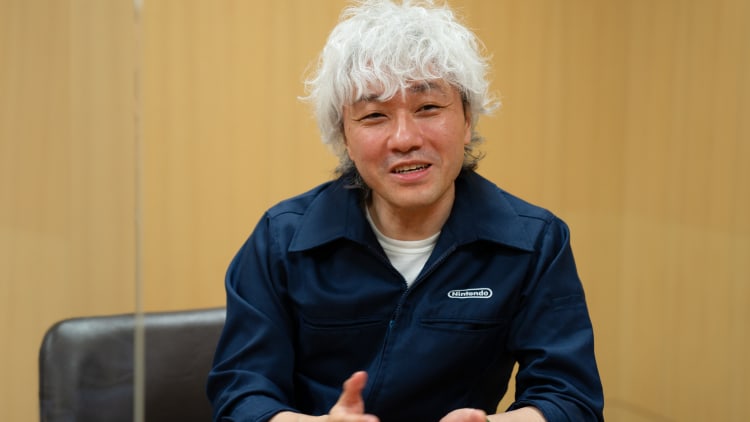
Shimamura:
I thought we could carry over some elements from the original titles, and it would be easy as 1, 2, 3... (Laughs)
So, everyone thought it would be easy to get at least as far as recreating Wii Sports.
Okane:
No, the programmers were all thinking, "It is not going to be easy at all..."
Everyone:
(Laughs)
Yamashita:
That's understandable. Unless you actually write the code (3), you cannot understand how difficult it is. As directors, we simply ask, "Please make it possible to experience this in this kind of way.” But the programmers are the ones who do the trial and error to make it happen. This is the hardest part. And yet, I only remember the good memories of developing the past titles, so I tend to ask for them casually. So, um... My apologies! I would like to take this opportunity to apologize...
Everyone:
(Laughs)
(3) A game program that describes, in programming language, what kind of input (motion control, button operation, etc.) and what kind of output (character running, throwing a ball, etc.) are performed.
Part 2: Beyond 90% detection
You mentioned earlier that it was not easy to implement on the Nintendo Switch system what was achieved on the Wii system. So, I would like to ask the programmer Okane-san, what exactly are the differences between the Wii system and the Nintendo Switch system?
Okane:
First of all, Wii Sports used Wii Remote™ (4) as a controller, and we incorporated it into the game while thinking about what gameplay could be done with the Wii Remote. But with the Nintendo Switch system, it was the opposite. Initially, the idea of playing sports by swinging was already decided, and we had to figure out how to implement this idea with the Joy-Con controller. As a programmer, this required a lot of trial and error.
(4) The primary controller designed for Wii system home game console, released in 2006. This controller has a vertical shape, similar to that of a TV remote controller, and was designed to enable intuitive and easy-to-understand operation at a time when Nintendo was aiming to expand the gaming population.
To the untrained eye, you would think that since you swing both the Wii Remote and Joy-Con controllers, and they should contain a sensor for that purpose, it could be achieved easily....
Okane:
If you hold a Wii Remote, it has a certain amount of weight and size. When players play Tennis or Bowling with this weight, it enables them to control the Wii Remote controller naturally with just the right amount of swing for the game. Therefore, it was easy to guess how the players would hold and swing it, and as a programmer, it was relatively easy to detect how it was swung as well. But the Joy-Con controller for Nintendo Switch is much smaller than the Wii Remote controller. So it varies a lot from person to person in the way they hold and move it.
Certainly, when the controllers are smaller it is easier to swing the arms freely, and I understand that they can swing in many different directions. But how does this actually affect the game developing process?
Okane:
It is difficult to put into practice the motion detection: "if you swing like this, it should react like this," in a way that satisfies players.
In a way that satisfies players? Does that mean making sure that things like, "I thought I swung it, but it didn’t get recognized," won't happen?
Okane:
Yes. Also things like, "I thought I swung left, but it went to the right." As we progressed, we could implement the detection so that about 80 to 90% of the time, it reacted as expected, at an early stage. However, applying the final polish to motion controls so that they feel natural and completely satisfying when you use them is very difficult. Both Shimamura-san and Yamashita-san mentioned earlier "aiming for the world’s most easy-to-invite to, motion-based game.” To achieve this, it's critical to work on detection beyond 90%.
What were your thoughts on this, Yamashita-san? Did you feel that you could achieve the adjustments “beyond 90%"?
Yamashita:
Well, it was tougher than I thought. This is because when we actually made the game and played it with a group of people who had played the previous series, they were able to play it without too many problems. However, when we invited someone who had never played this game before to try it, the ball did not fly in the direction they expected at all. I can understand "the grip is different," or "the swing is different," but there were times when people said things like, "this is not how you move in the actual sport!"...
Not how you move in the actual sport? What does that mean?
Yamashita:
Take volleyball, for example. In real volleyball, you don't move your arms and wrists when bumping. Once in the bumping position, the player keeps the hands in a fixed position and returns the ball, using the knees to push through. This is the official way of bumping in volleyball.
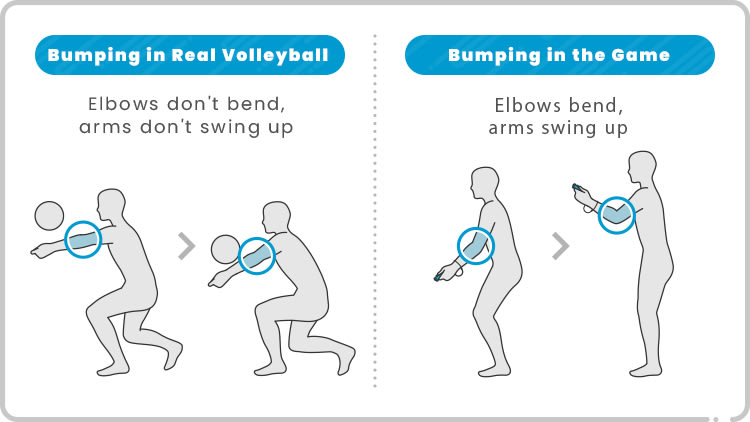
I see.
Yamashita:
But if you've never played volleyball before, you'd think they were launching the ball in the air by swinging their hands and arms up, wouldn't you? However, the programmer in charge of developing Volleyball was an experienced volleyball player. So, the programmer had the "official bump" move required in the game as well. When we tried the prototype with everyone, as expected, everyone swung up their hands holding the Joy-Con to bump the ball. Strangely enough, even those with volleyball experience did the same move. But the program was designed on the premise to "keep your hands still," so the ball would fly in the wrong direction. In other words, the programmer, who was an experienced volleyball player, created a game mechanic where the player had to keep their hands stationary, set the angle, and bump...
It sounds like it's hard to control unless you know the gameplay.
Yamashita:
That's right. It's fun when you know how to play with that gameplay. “Oh, so authentic! This is just like volleyball!” But when we tried it together without any explanation, almost everyone swung their arms up. We all thought, “What are we going to do with this!?” So, we get to a point where we think this is going to have to be a game mechanic where the player needs to swing up. But then the programmer in charge, who has real volleyball experience, will be concerned that the volleyball-ness may be lost.
But even when people with actual volleyball experience played, they were still swinging their hands up, weren't they?
Yamashita:
Yes, they were. Considering that, the only way to make a game that people who know nothing about it can play naturally with a quick glance, is to make it a gameplay where players swing their hands to bump after all. ...And so, after some discussions, all the methods to identify the movement were reworked.
Regardless of whether it is the actual move or not, it is indeed easier to understand if the ball flies in the direction that you expect it to.
Okane:
If the game is to be played for a long time and thoroughly, it may be an option to do it with authentic and correct volleyball form. However, I felt that it would be difficult to convey the fun of the game in a short period of time, while at the same time having the player read the operation instructions carefully upon playing.
Are such adjustments only in Volleyball? Have there been any adjustments in other sports as well?
Yamashita:
There were fewer sports that actually went smoothly. (Laughs) In the planning stage, there were already some kinds of adjustments necessary for all the sports. For example, Badminton. The appearance is similar to Tennis from the previous games in the series. At that time, in Tennis, the direction you hit the ball back was determined by the timing of the swing. If you swung at an earlier timing, the ball would fly to the left, and if you swung at a later timing, you could hit the ball to the right.

If you try to put that same concept into Badminton, and ask someone who doesn't know the premise to play, they may say, "I don't know why the timing of the swing changes the direction in which the shuttlecock flies!" Shimamura-san and I know that it is not the direction of the swing but the timing of the swing that determines the direction in which the shuttlecock (feather) flies, since we know the method of the previous titles. But those who played without knowing this premise, will say that it just doesn't feel right.
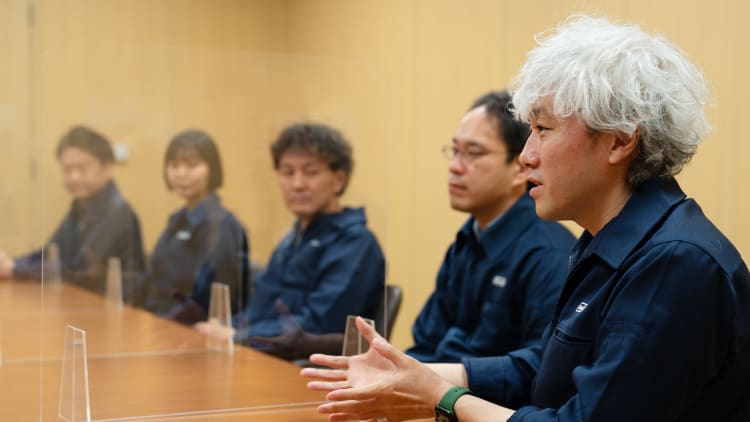
Was it not possible to actually recognize the direction in which the Joy-Con controller is swung in Tennis and determine the direction in which the ball is hit according to that recognition?
Yamashita:
When you actually play it, that method is very difficult. When we try to figure out the direction of the swing and use it to determine the direction in which the ball flies, it makes the controls unstable, and the ball doesn't fly in the direction you expect it to. Even when Wii Sports and Wii Sports Resort were being developed, I was told by the programmers, "Please don't make it like that.” However, there were suggestions from the staff members who were not familiar with the trial-and-error process at that time saying, "We want to recognize the direction in which the shuttlecock flies by the direction of swing."
Okane:
I do understand that badminton is a sport in which the shuttlecock will fly in the direction that you swing. I knew it was going to be difficult since it had already been experimented with over and over again previously in the series.
Yamashita:
As a director who has experience working on previous titles, asking them to achieve it when you know it's technically difficult was tantamount to "losing." So, the director has to solve the problem with ideas on how to make the motion controls feel natural, and not through technology. I was saying, “That's what directors do!” But eventually, I had them solve it with technology. However, there was no way it would have been so easy.
In this title, how did you overcome what seemed technically impossible at the time?
Okane:
We just did a lot of trial and error. In terms of new technology, we tried deep learning (5), which was not available when Wii Sports was developed.
Deep learning?
Okane:
For example, we asked various people to "swing as if you were hitting to the left," and "now swing as if you were hitting to the right," and repeated the process over and over again to acquire a large amount of data. It is a technology that detects if the player is trying to hit the ball to the right (or left) by statistically analysing that acquired data. So by incorporating such technology, and experimenting with this and that, we tried to bring it up to a level that everyone could agree on.
(5) Machine learning technology captures large amounts of data, such as images and video, into computers and analyses the characteristics of the data.
Yamashita-san mentioned earlier that it is very difficult, but Okane-san, how did you feel about the direction of the swing determining the direction of the ball?
Okane:
I thought it would be difficult. Deep learning is an excellent technology, but it is not magic. If we can get enough data "from the beginning of the swing to the end of the swing," we may be able to estimate the correct direction. But if the ball reacts and flies out after the player has finished swinging, the players would feel it's not responsive, and it's one step behind. So then, if we try to use data from just before the end of the swing, the correct movement cannot be estimated because there won't be enough data this time. In other words, there is a trade-off between aiming for "accurate detection" and "satisfactory response as a motion control." So, we made adjustments over and over again tenaciously saying things like, “I think it's somewhere around here!... No, maybe it’s somewhere around here!”

But with the accumulation of these steady efforts, the 80-90% you mentioned earlier got closer to 100%, right?
Okane:
Yes, so I would say that we could reach about 90 to 95% detection rather smoothly. But the last few percent was really tough... For example, when a player serves in Badminton, and even if the shuttlecock flies as expected nine out of 10 times, if the player misses even once, they will think, "Hmm, it's hard to control..." So, even though it's impossible to reach 100%, it is very important to work on this last small percentage, even if only by a little. This is no longer something that can be solved with the latest technology, so we all worked hard by getting as many people as possible involved and making detailed adjustments.
Shimamura:
Every day, we would hit 200 times each to the right, left, and centre to see how the latest adjustments worked. My right arm was so pumped and crab-like. (Laughs)
I guess developing a motion-based game is hard when it comes to testing, too...
Yamashita:
It is a sequel to the previous games in the series and also a motion-based game, but as explained, it couldn't be just a simple port. I think all the sports were close to being rebuilt from the ground up in a way that was adapted to the Nintendo Switch system.
Part 3: A sense of continuity
So far, we have heard how you refined the motion controls in this title to create a sequel to Wii Sports. Could you tell us what else is new in this latest instalment of the series, other than the controls?
Shimamura:
We were always conscious that our customers would feel pleased that they had purchased a new, stylish product. We didn't want it to be a mere carry over or remake of past titles.
Yamashita:
We not only focused on adding new sports but also consulted a lot with Morii-san, who was in charge of the design, about how to make the design look new and fresh.
The Mii™ characters (6) left quite an impression in Wii Sports, but there are some new characters added to this title. Did you add these characters to show the freshness of the design?
(6) A system implemented on the Wii system in which players can create caricature characters by combining various facial features, such as face shape, eyes and hairstyle. In the Wii Sports series, players can play in each sport as the Mii characters they created.
Morii:
Even before we decided to make a fresh start again, we had proposed different kinds of character illustrations. In the early stage, we proposed round-shaped characters with no arms or legs, similar to the Mii characters in Wii Sports. We also created college student characters that looked like this with a theme of intercollegiate sports.

Shimamura:
I remember we had the most outlandish characters that looked like robots. (Laughs)
Morii:
Around the time when we decided to restart the project from scratch and were told that we would be starting over to create the world’s most easy-to-invite to motion-based game, I asked, "Are you sure we can't go this far?" (Laughs)
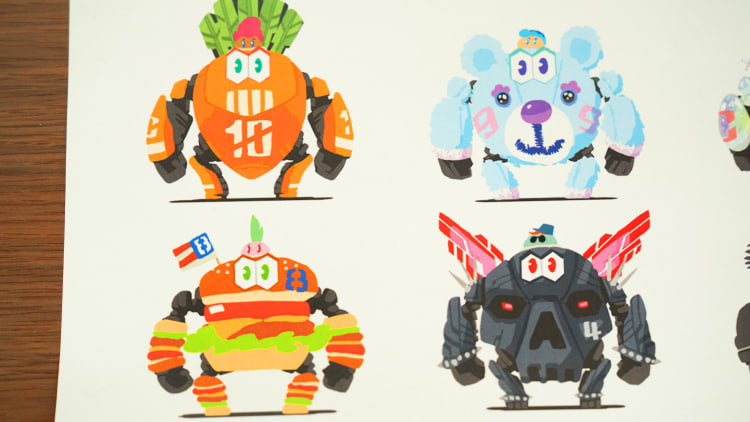
The player is inside the robot, but it is the robot that moves when you swing the Joy-Con controller. The robot is the one doing the bowling.
What? You operate the robot?
Yamashita:
Yes, you operate this robot, and the robot throws the ball. I know it doesn't make sense. You might also wonder how big this bowling alley is. (Laughs)

Morii:
At first, everyone was so excited about this robot idea that we all thought, "This could be fun!” We even made a prototype. But when we actually saw the robot on the screen and moved it around, a blanket of silence fell over everyone.
Everyone:
(Laughs)
Okane:
This would make the gameplay about operating a robot.
Yamashita:
The player controls the character in the robot to operate the robot. Then, the robot throws the ball. There are too many steps in between.
So you ended up going in the wrong direction after refining the motion controls.
Morii:
As a result, we decided to go with a design that resembles a human being.
Yamashita:
However, the Mii characters in Wii Sports didn't have arms. The sphere was considered a hand, and even if the ball went a little far away, the hand would fly out and hit back. It did not look unnatural because of the lower screen resolution at the time and that character setting. But I thought it would be difficult to incorporate it into today's game consoles. Also, I was quite certain that in the memories of our customers, the Mii characters have arms.

Oh wow, they have changed a lot from the past and wear stylish outfits.
Morii:
Yes, but a lot of work had to be done. When we were making Wii Sports, the Mii characters had about 30 different animation motions such as running, swinging a racket, and hitting a serve. But when we tried to recreate the same movements with Sportmates, we needed over 650 different motions in the end.
650? Why so many more?
Morii:
If the arms are connected to the body, a separate motion is needed for each angle that characters hit back, and an animation is required for each direction they move including forward, diagonal and back. We also had to create a walking version and running version for each motion, so the workload kept increasing. (Laughs) The programmers and animators worked very hard. But I believe we were able to create a good title because of the hard work.
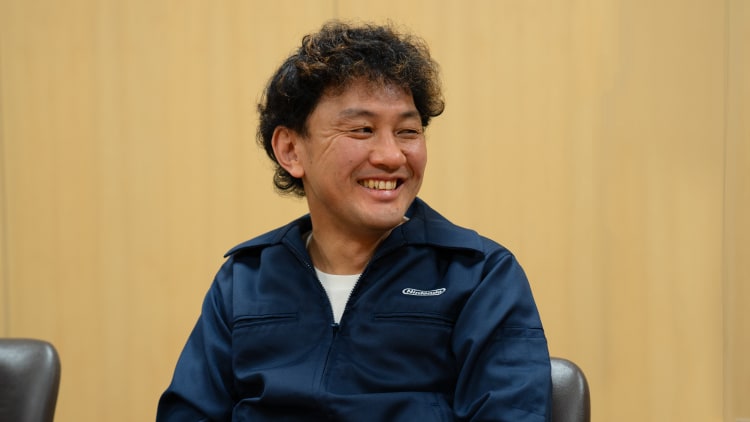
You pursued making the characters move naturally so that players experience motion control intuitively. Could you tell us about the design of the setting where the sports are played? The design also seems new in this title.
Morii:
For Spocco Square, the setting for this title, we designed it to create a sports complex that doesn’t exist in real life but would be nice if it did. As we did for the characters, we tried various ideas for the stage design. I talked about college student characters earlier, but we also proposed a setting that resembles a place where intercollegiate sports are played as well as a setting that looks like an ancient Olympian stadium. I asked the team to build a prototype set in a stadium with a large audience, like the ones used for professional games, but none of them seemed to match the feelings that players would experience playing this game.

Okane:
Yamashita-san often used the term "a sense of continuity" to describe this feeling.
Does that mean a sense of continuity from the real world to the world of games?
Morii:
It's more like a sense of continuity in terms of feelings. We wanted our players to experience something similar to what they would feel playing sports as a leisure in the real world. Like something that extends from their daily lives. This game doesn't require any difficult techniques to play, and it's the kind of game you can casually play by asking, "Hey, let me borrow the controller," or "Let me play, too.” However, if you casually grabbed a controller and asked to borrow it for a moment but were suddenly brought out in front of a large audience and were in a situation where you were cheered like a professional player, you would not feel comfortable. Instead, we thought it would be better to make it a gym where people could drop by more casually, with a stylish facility that makes everyone want to visit. This is how the design came to be.

This is a place created by renovating a warehouse district in a port town. It is a kind of facility that you would not be surprised if it were a part of your life, but we avoided making it too realistic. It’s a place you wish you had in real life. We also kept in mind that it should be a fun place whether you go alone or with others. In Wii Sports, I think people had a strong impression that you gather in the living room with family and friends to play together. However, since players can enjoy playing online (7) by themselves as well as with others in this title, we made sure to create a design that accommodates the level of excitement of players who play on their own.
(7) Any Nintendo Switch Online membership (sold separately) and Nintendo Account required for online features. Not available in all countries. Internet access required for online features. Terms apply. nintendo.com.au/switch-online
Okane:
After this design came out, the mood amongst the team changed. We all thought, "I see. We are creating sports to be played in this kind of facility.” It made sense.
I see. Knowing the direction of the design enabled the entire developer team to unify.
Morii:
While it creates a feeling that players can start playing naturally, it is a fresh new design, and all of us could see its possibilities. We spent a lot of time trying to come up with a new look and feel, and we came up with so many ideas, but I don't think it was a waste of time. Even the ideas that were not adopted were essential in arriving at the current design. In creating an atmosphere that is easy for anyone to understand using motion controls, we discussed within the team saying things like, "Robots don't seem right, nor ancient Greece," and eliminated and refined many elements.
How about the sound? Did you try anything new?
Yokoyama:
I thought we had to do something new with the sound, but for me, the members in charge of the sound for the past titles were like legends. The sound for Wii Sports was so well done. Not only did they create the "pleasant" sounds for motion controls, but they also created an ambience for playing sports with background music and environmental sounds. More than 10 years have passed since then, and of course, the data capacity has increased and the sound resolution has improved, but we also felt that we had to show something new and searched for what we could do.
You were aware that the proposals for college student characters and robots were being made, right?
Yokoyama:
Yes. We saw these proposals for college students and robots coming up while experimenting with various ideas, and I thought to myself, “Hmm... What should we do...” (Laughs) Since motion control is of primary importance in this title, we felt that we would not be able to incorporate too many unique elements in music with college students or robots. But when the design for Spocco Square came out, we felt like the missing pieces had been filled in.
You would have to create a different kind of sound for robots, right?
Yokoyama:
Yes, we would have to make a noisy "clunk, clunk, clunk" sound. I was like, "This is a motion control game. What should I do with the sound?” (Laughs)
Everyone:
(Laughs)
Yokoyama:
As Okane-san mentioned earlier that the mood among his team changed after the design came out, I think my team was also able to take on a variety of new challenges based upon the design concept. I could think about what kind of sounds I would like to hear if I visited the complex as a player.
Speaking of new sounds, you have background music playing while you play in this title, right?
Yokoyama:
Yes. When thinking about the background music, I tried to imagine what I would like to hear if I were in Spocco Square myself, playing sports. In the past series, there generally was no background music during matches, and I feel it was effective for creating a sense of tension in a serious match.
I feel that the intention was also to make the sound effects for motion control stand out by eliminating background music. But I thought it wouldn’t make sense to have no background music in this complex when players come here to play casually.
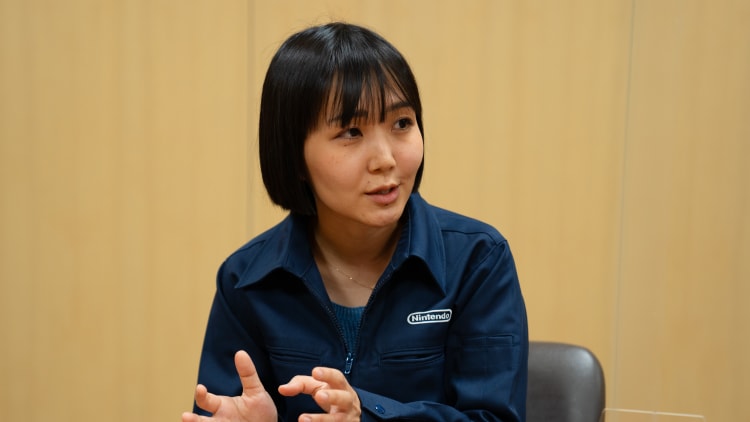
So you are saying that not only is it fun to have background music, but it makes it feel more natural.
Yokoyama:
Yes. However, if the background music stands out too much, it would overshadow the sound effects for motion control. To prevent this from happening, we assumed that there were speakers near the stage of each sport and that background music would be playing from them. We then balanced the sound with the sound effects to create a sense that players are actually playing in this facility.
Earlier, we discussed how this title also focuses on playing alone. I think the impression that players get playing the game changes considerably with and without background music. Increasing the layers of sound made it more accessible for players to enjoy playing on their own repeatedly.
Yamashita:
If the design, sound and motion control are too off-the-wall, people would think that this game is something irrelevant to them. If they are too far from what the players expect, the players won't feel connected. To avoid this and achieve the feeling of continuity, our members supported this title with technology and technique.
I see. From the players’ point of view, these aspects may not be something they would pay much attention to, because they wouldn't think anything is weird, but it is precisely in these areas where attention to detail is hidden, right?
Yamashita:
Yes, that’s right. I know it’s not cool to say this here, but I hoped players would not notice these hidden details. (Laughs) This is not a game about being flashy, so if someone says, “This detail here in this game is really well done!” we lose. Therefore, in everything we did, we valued the sense of continuity of feeling and that people could play naturally.
Part 4: Playing with others is inherently fun
You have mentioned that you made this title more user-friendly for players to enjoy playing on their own. What were the key points you focused on in this process?
Shimamura:
From the very beginning, we wanted players to enjoy the online matches as the main feature of the single-player mode. We felt that in the Wii Sports series, the fun you get playing alone against computer-controlled opponents would be nowhere near the joy you get playing with others. That's why we wanted to overcome this challenge with the online matches this time.
I see. But I feel that some people may think that online matches are too much for them. What do you think about that?
Yamashita:
First of all, if you look at the design, you can see that we placed the option for online matches at the top of the menu. When you make a party game, you would normally think that the order on the menu would be "Play with Family," "Play with Friends," followed by "Play Online." But in this title, we wanted to get rid of that feeling of getting ready to go online. Therefore, the menu looks like this.

Morii:
It's not written in such a way that "Play online" is the main focus.
Yamashita:
Some people said that they would be too scared to select if it said "Play Online." Therefore, we tried to ensure that the word "online" does not stand out too much. After all, players can play with someone in any of the options. The only difference is whether it is a family member or friend close to you or someone else somewhere in the world.
With this wording, I feel that I would certainly start playing online without being afraid of anything.
Shimamura:
We also wanted players to enjoy playing against someone rather than just focusing on winning in online matches. This idea has always been important to us since the launch of Wii Sports in 2006. It is frustrating when you lose. So we made it our basic premise to create a game that would not upset people who do not usually play games when they lose and make beginners feel like, "I'm done with this." We were conscious of this point when we created an online mode in this title. You can earn some points whether you win or lose. The points you earn can be redeemed for in-game items such as the outfits for Sportsmates.
I see. There is some element of fun that is not just about winning or losing.
Morii:
There are many different items, and we worked pretty hard on this part. We are still working on new items even after launch and will release about 10 items* in each weekly update during the first year after launch, including outfits, stamps and titles. We think players will have fun just collecting the items.
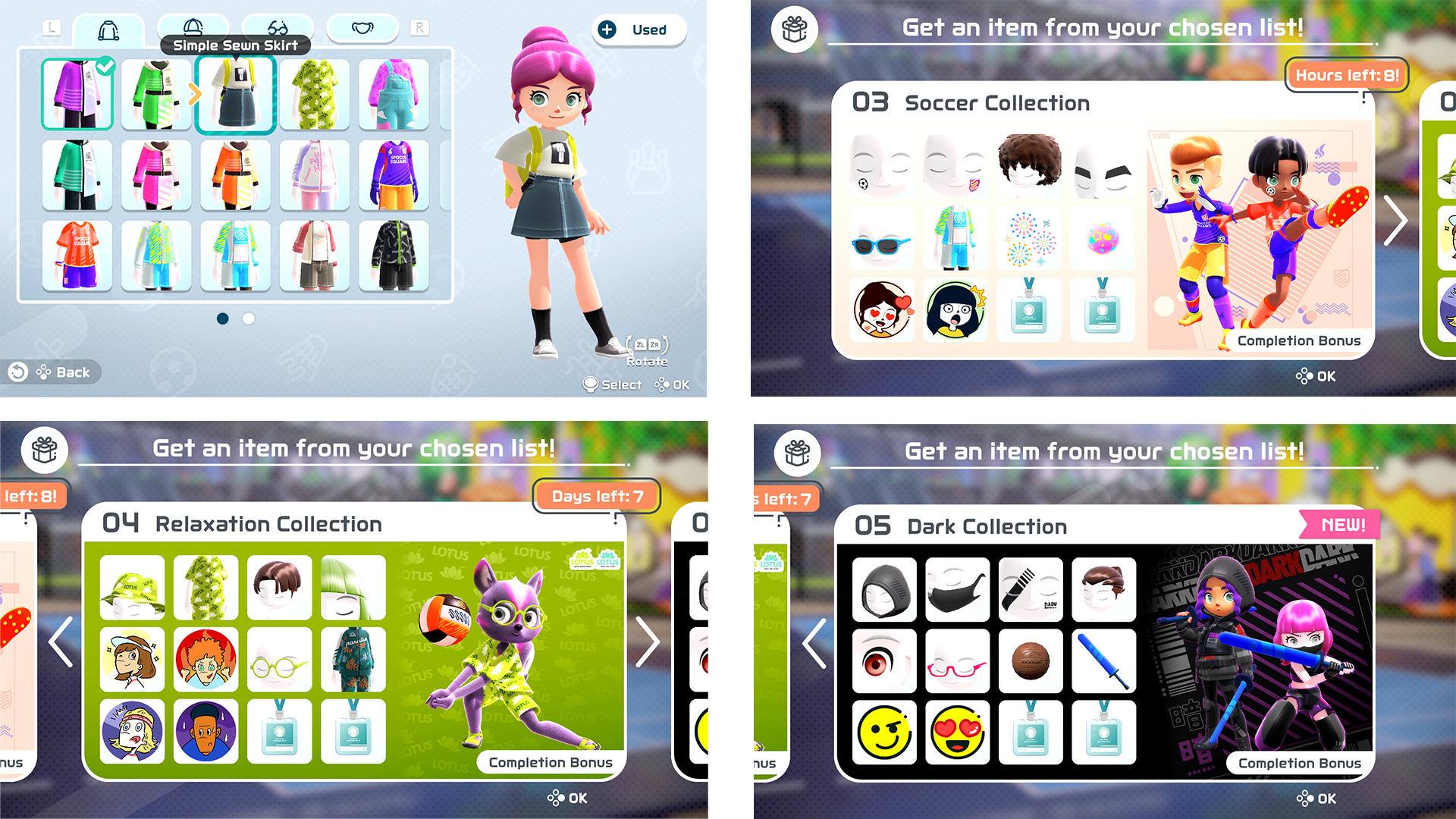
Yamashita:
However, since some players would likely want to see how much they have improved, we are offering a "Pro League."

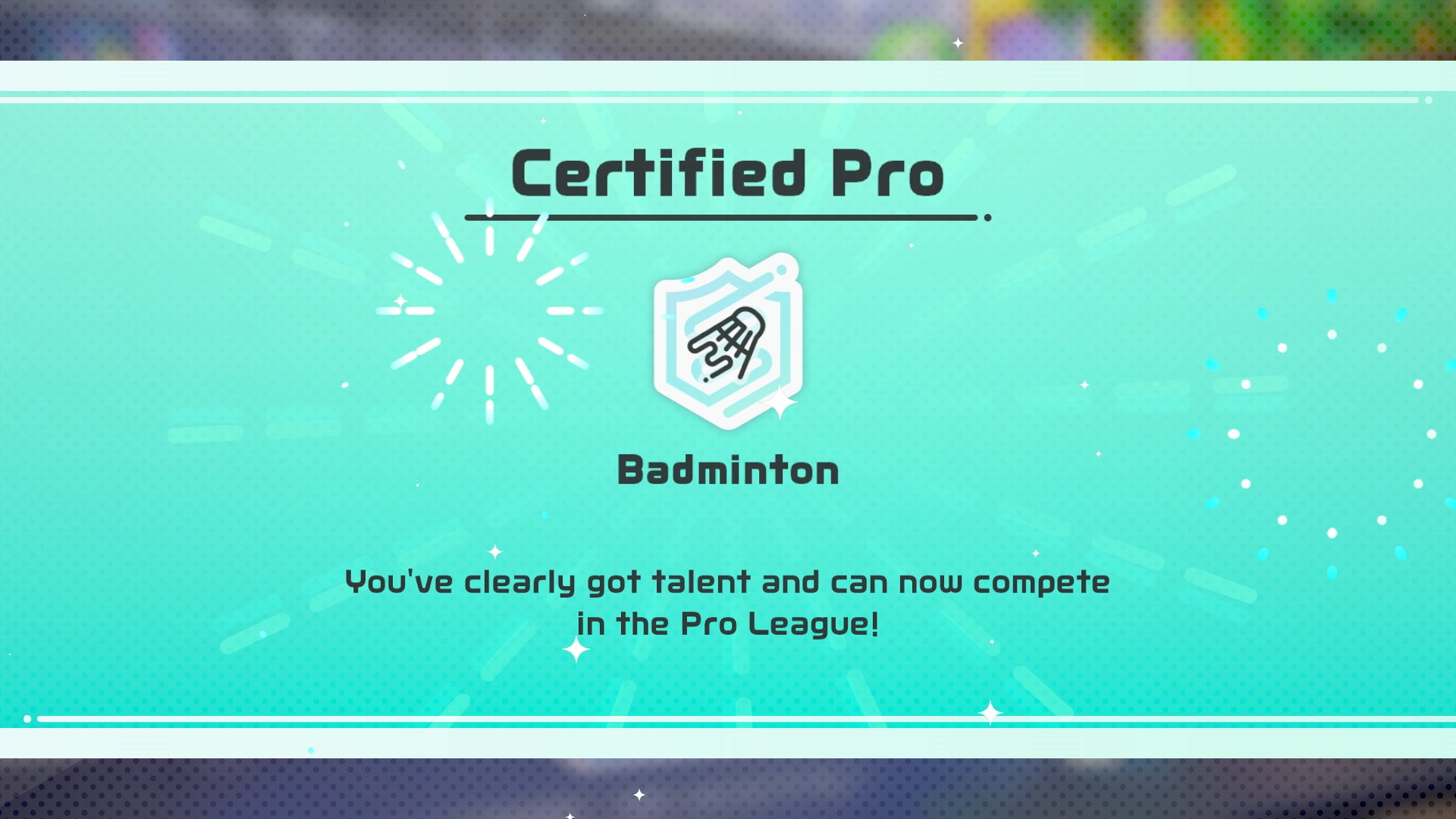
When players have become accustomed to online matches to some extent, they will be invited to join a Pro League in each sport. We offer various ranks based on their level. We thought that some people would be nervous if they saw the Pro Leagues from the beginning, so we designed it in such a way that players will be naturally guided to it once they have reached a certain level.
Shimamura:
Also, we tried something a little different and incorporated an option for pausing the Pro League. We don't think you see this feature often in other games.
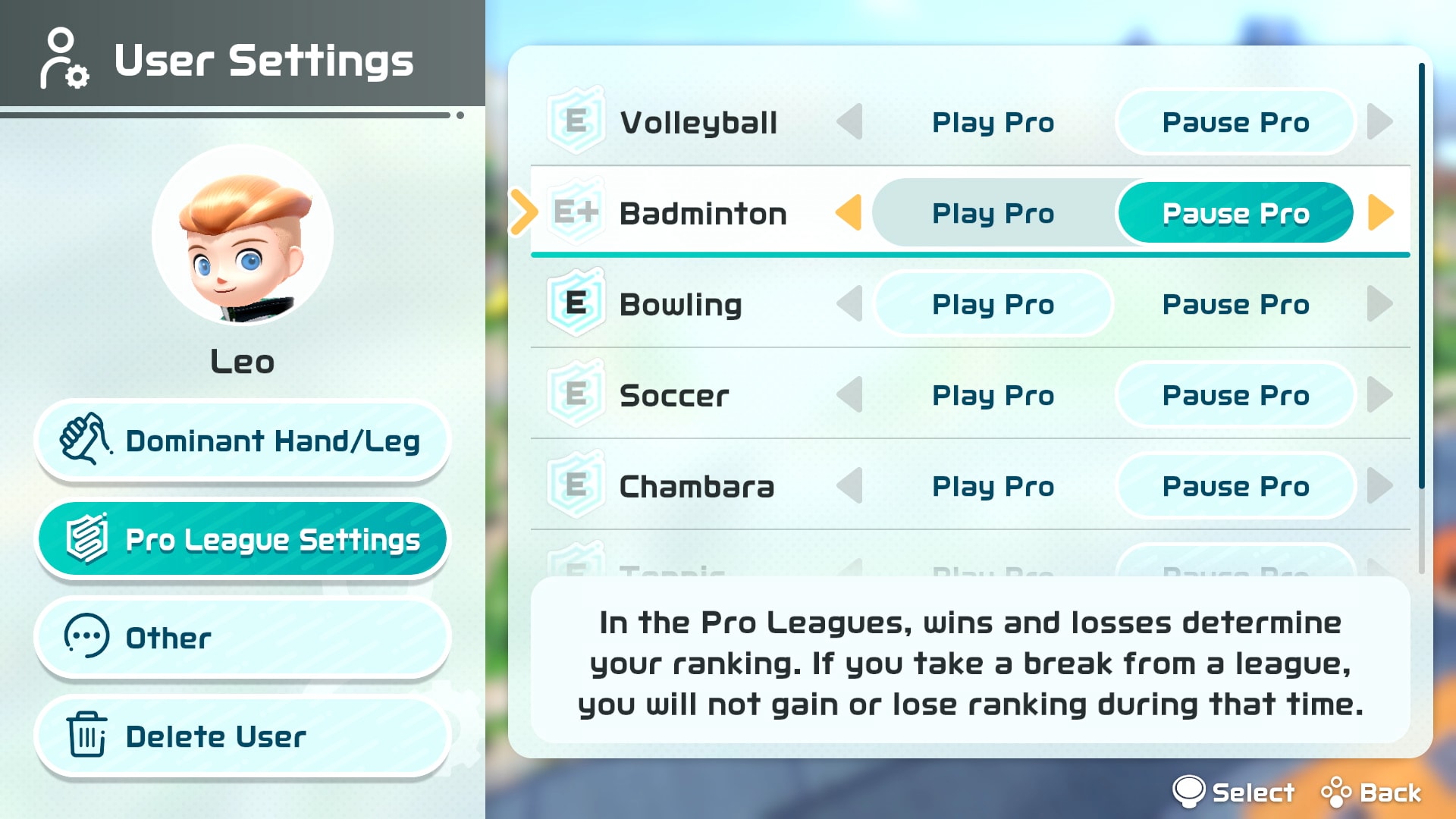
Pausing? What does that mean?
Yamashita:
Whenever there are winners in competitions, there are just as many people who lose and feel frustrated. To avoid players feeling pressured to win, we created an option where they can pause a Pro League and take a break. Playing with others should be inherently fun. For instance, when you play badminton on the rooftop during lunch break, I don't think you would take it too seriously, being happy you won or disappointed you lost. Therefore, we wanted to bring that feeling of fun you get regardless of whether you end up winning or losing.
I see. Winning may be one way to enjoy the game, but you simply want the players to enjoy playing online against others. It seems that you can easily play online in all sports.
Yamashita:
That's the thing. Initially, we did not say we would make all sports available online. Well, I wanted to make it happen, but I tried not to say it to our staff members. It is actually extremely difficult to make a motion-based game available for online play.
Okane:
Motion controls feel good because your actions are immediately reflected on the screen. However, a time lag would be inevitable for online play because the data is sent online. Therefore, these two elements are contradictory.
So that means you couldn't apply the program for local multiplayer to online multiplayer?
Yamashita:
For example, in Tennis where players play next to each other in a local multiplayer, the program recognizes if the player twists their racket – the Joy-Con controller – after swinging it, while the ball is flying, and changes the direction of the ball. Players can enjoy a smooth response by seeing the direction of the ball change as they twist their racket and experience the game immediately responding to their movement when hitting the ball. However, since there would be some time lag in online play, the ball may have already reached the opponent by the time the game recognized that you have "twisted the racket" and tried to change the ball's behaviour. That is why we cannot use the same program.

Okane:
Since it was difficult for us to apply the know-how we gained in local multiplayer to achieve a better response, we had to rethink new ways for movement detection suitable for online matches. Moreover, the areas that needed tuning were completely different for each sport. Making each sport available for online play took as much work as creating a new online game. That is why I said over and over again how difficult it would be to make all sports playable online.
Shimamura:
I remember being asked several times "Which is more important, the motion control or the online experience?!" during the development process. I answered, "Both..." feeling a little apologetic. (Laughs)
I see. Such efforts were made to achieve a smooth online experience. Are you satisfied with the outcome?
Okane:
It's not "perfect," so I would be nervous until I see the reactions of the customers who play this game. (Laughs) We tried playing the game within the team and worked hard until we could all be satisfied with our work.
Shimamura:
The reactions to the online play test we conducted before launch also gave us confidence.
From what I have heard so far, I have learned how you focused on motion controls and paid careful attention to detail not only in the design and sound but also in online play to provide a smooth experience for players. Since you are all here, let's play the game together now.
Yamashita:
Then, let's play Volleyball which is a newly added sport for this title.
Shimamura:
Let's go!
Yokoyama:
Argh! Here goes!

Okane:
Oops...
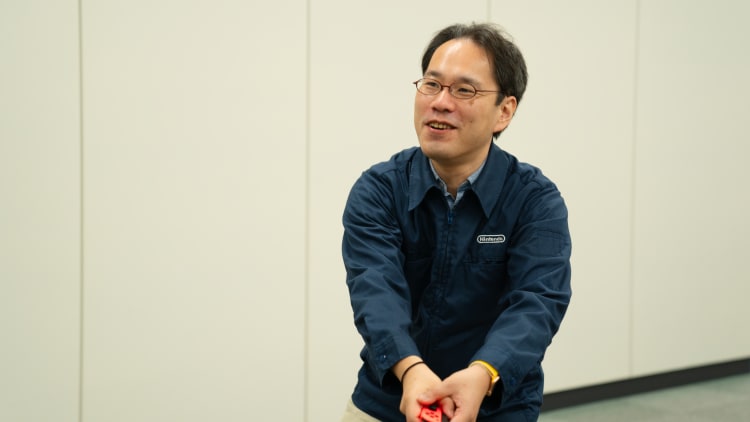
You are all swinging up your hands to bump the ball.
Shimamura:
That’s right. Speaking of which, this is a motion-based game, but you can play it sitting down. Let's play Chambara sitting down.
Morii:
Well, I'll use the new Charge Sword.
Shimamura:
I'll use the Twin Swords then... I won't lose!
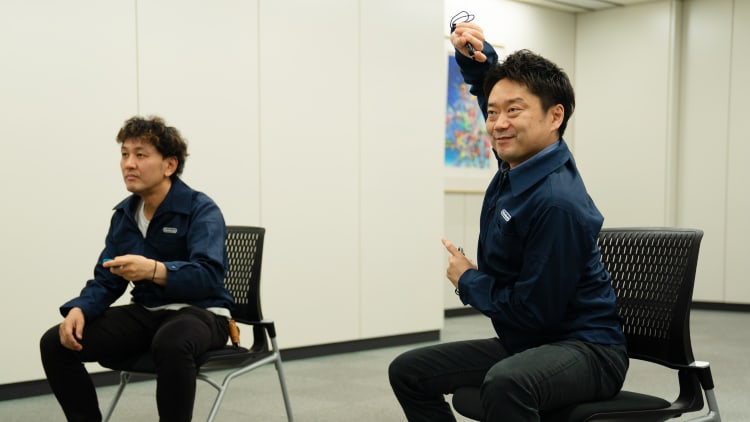
Morii:
Ow!!!!
Shimamura:
Oh no!!! Gah!!

Morii:
Playing Chambara after Volleyball is great exercise. (Laughs)
This is pure sports. (Laughs)
Yamashita:
Playing Bowling side by side feels like real life.
Morii:
Shall we all throw after saying one, two, three then?
Everyone:
One, two, three!

Oh, wow! You are all as good as I thought. Nice spare!
Shimamura:
One more time. Here we go! Morii-san, you are really good!

Morii:
Hehehe...
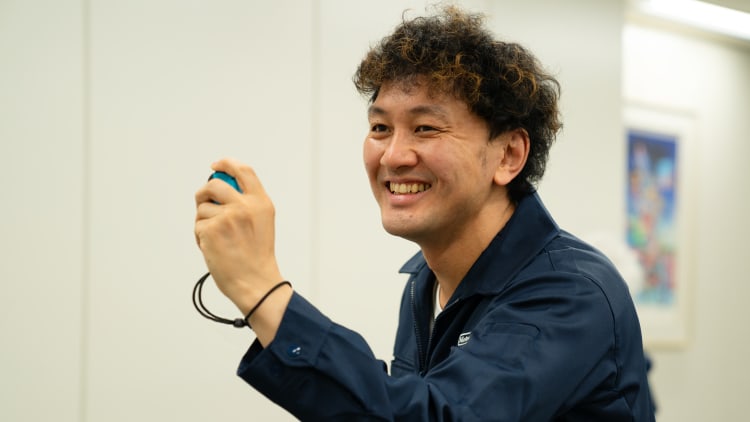
I feel like I am watching you all play from behind in an actual bowling alley. You all seemed to be enjoying playing the game in a relaxed manner. Thank you very much. Finally, could you give us some comments on how you would like the players to enjoy this title?
Yamashita:
In Wii Sports, we received some happy comments from all generations, such as, "My grandpa and grandma played bowling with me!" In this title, I would be happy to see these people saying, "I found myself playing online." It would be fun and interesting if a super player you came across in a bowling match turns out to be someone close in age to your grandpa or grandma.
Okane:
I think we all had the impression that Wii Sports is a party game which everyone gathers together to play. However, the programmers worked very hard on this title so that customers could also enjoy a smooth online experience. We often had to work from home during a significant part of the development period due to the pandemic. However, we were able to develop the game with excitement, thinking, "It's actually quite fun to play together from different places like this," and I am sure you will all enjoy playing it too. We also have a "Trial Mode," which enables you to experience online play even if you are not a member of Nintendo Switch Online, so please try playing it with your family and friends.
Morii:
In this title, we have Sportsmates in addition to the Mii characters. We hope you will take note of the unique and extensive range of outfits available for them. Also, there are quite a few areas where we used a “single line" as a design concept to express the sense of continuity. For example, we drew the badminton court line as a single line, and another line that stems from this line is connected to the bowling facility next door. I hope you will enjoy looking for other places where we used single lines.
Yokoyama:
By changing how the sound resonates in each facility and thinking how it would sound like considering the location of each facility, we focused on creating the sound in detail. Since each round of gameplay is short, we created this title, hoping that players will make small discoveries each time they play the game. We also want you to have a different impression of the sound each time you play the game in different ways. So it would be great if you could listen to it carefully when you have time.
Shimamura:
If you have a copy of this title in the household, you can easily set it up and play together even when you have guests. But in such cases, there is often a gap in ability between hosts and guests because the hosts are used to playing it. If the hosts take the game too seriously, the guests may feel uncomfortable. On the other hand, if the hosts took it easy on the guests, the guests would think, "Ah, they are not taking me seriously." When two people with a gap in their skills play the game, please try playing online together and enjoy cooperating to play against online rivals. When your team wins, both of you will be happy, and even if your team loses, you can comfort each other. It would really feel like you are pairing up with someone and playing a sport. Please don't be afraid to play online – it's fun!